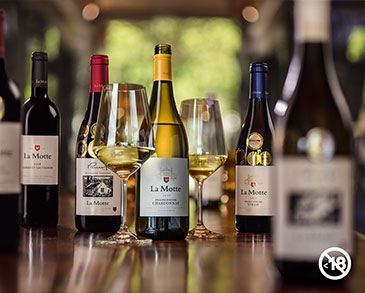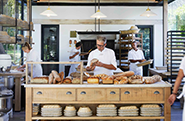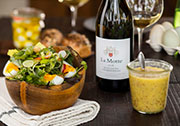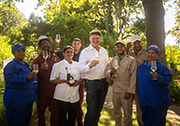
“Of course the build-up to harvest is a whole growing season with varying conditions – untimely rain, gale-force winds, excessive heat – and although we had all of these, they counteracted each other well enough for optimal conditions for a quality 2013 vintage”, says La Motte Cellar Master Edmund Terblanche.
Speaking to winemakers and viticulturists from various growing areas in the Western Cape, there seems to be consensus that 2013 was indeed an exceptional vintage.
Nederburg Wines Cellar Manager, Razvan Macici praises the 2013 harvest for having both good volume and quality. “The season was short and intense and concentrated: it started later than normal and finished earlier. The grapes were physiologically ripe, with good flavours, good colour, ripe tannins and good acidity.” He is also very satisfied with the quality of their Special and Noble Late Harvest.
“I have been making wine for 27 years and 2013 is really one of the best vintages of my time. Not only have we harvested good volumes, but the quality is exceptional. The whole industry can look forward to the 2013 wines”, says De Grendel Cellar Master Charles Hopkins.
In the Cederberg the season was warmer and for Cederberg Private Cellar’s Tammy Turck, Chenin Blanc with its better heat-resistance is out-performing Sauvignon Blanc. But it is the reds they are really excited about: “2013 is a year for red”.
Arco Laarman from Glen Carlou in the Paarl region feels that 2013 is potentially the best vintage since 2009. “Our Chardonnays have performed well and I do feel that 2013 could be a stronger red variety year than the previous two. The surprise of the year is Cabernet Franc; I think it could be the best we have ever produced.”
“We are very excited about the 2013 harvest – especially the early varieties such as Pinotage, Chenin Blanc, Chardonnay and Sauvignon Blanc”, says Zakkie Bester of Riebeek Cellars in the Riebeek Valley. “Having said that, our red wines have lovely flavour and colours are deep and intense.”
And although there are always some elements that could have been better, those contributing to the exceptional quality are especially low pH measurements, very good colour and intense aromas and characteristics.
Rain:
“The winter before the harvest has an important role to play in the eventual quality of wine grapes. We need cold for decent dormancy and rain to replenish the water levels. Last year, we received both”, says La Motte Cellar Master, Edmund Terblanche.
With a very wet winter and around 35% more rain than the long term average, underground water has been replenished and this year water has not been too much of a concern. Even the Walker Bay area that suffered a two-year dry spell had enough rain to last the season. The last drenching rains fell mid-October and although a dry and warm December and January caused worries about soil humidity, the late rains enabled vineyards to cope with the heat and windy conditions. The dry conditions were positive to keep diseases at bay and to ensure optimal flowering.
On 9 February some thorough downpours interrupted the harvest for a few days. Although some areas had problems after the rain, many did not suffer too much and the rain was positive for late cultivars like Cabernet Sauvignon. The light rainfall during the harvesting season also created good physiological conditions for the vines and replenished soil moisture so that water resources can be used for post-harvest irrigation.
Temperature:
An exceptional cold winter ensured ample cold units. Spring was mild to cool with more rain which was initially thought to postpone the season for about two weeks. Budding was proportionate and strong due to the good cold season and water levels.
But there also was heat. Not necessarily continuous heat waves, but according to Vinpro, the average temperature in December was the highest in 48 years. While enough foliage protecting vines, there was surprisingly little heat damage. Heat conditions also accelerated ripening and the season was not as late as initially expected.
January and February temperatures were mild and especially night temperatures were noticeably lower than usual. Ripening was gradual which made it easier to plan the harvest.
Wind:
Gale force South Eastern winds during November and December caused some damage to vines. Although shoot damage in areas such as Bot River is a reality, the harm was not more than expected for natural windy areas.
Wind damage to vines has resulted in a downward adjustment in crop estimates but windy conditions during ripening did prevent diseases and ensure healthy grapes.
Strong winds have dried out the soil, but good dam levels and the February rains ensured enough water for supplementary irrigation.
Volume:
According to Vinpro and winemakers in the Western Cape initial predictions was for the harvest to be very similar in volume to 2012, with the possibility of a slight increase. SAWIS’s Wine Industry Information forecasted a slight decrease of 0.4% on the 2012 vintage – largely caused by the strong winds at the end of 2012.
In general the volumes were good, but it did differ between areas. On La Motte in the Franschhoek Valley, Sauvignon Blanc volumes are slightly up on the previous year, but in Stellenbosch Sauvignon Blanc volumes are definitely down. Merlot and Shiraz volumes in Paarl and Franschhoek were also higher than in 2012.
Agriculture in the Western Cape had a turbulent start to the year, but it seems that the quality of the wine grape harvest at least is bringing some smiles to faces in the industry.
#Sustainability
#Harvest











